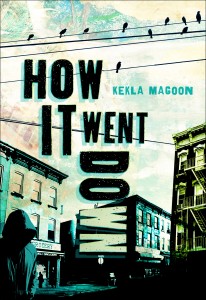 How It Went Down by Kekla Magoon (Henry Holt, 2014) begins with words similar to too many recent news stories – an African American teenager has been shot by a white man. The police arrest, and then quickly release, the shooter. The media descends as the competing narratives rise: was the young man armed, or did the shooter mistake a candy bar for a gun? Was he a gang member running from a robbery, or an innocent young man walking home from running an errand for his mother? Why did the man approach him, gun drawn, and how could it be self-defense if he was the one in pursuit of the teen? Family, friends, bystanders, the larger community, and everyone – including the reader – try to make sense of the shooting, and those closest to the loss start to reorder their lives around the hole left by the young man’s death.
How It Went Down by Kekla Magoon (Henry Holt, 2014) begins with words similar to too many recent news stories – an African American teenager has been shot by a white man. The police arrest, and then quickly release, the shooter. The media descends as the competing narratives rise: was the young man armed, or did the shooter mistake a candy bar for a gun? Was he a gang member running from a robbery, or an innocent young man walking home from running an errand for his mother? Why did the man approach him, gun drawn, and how could it be self-defense if he was the one in pursuit of the teen? Family, friends, bystanders, the larger community, and everyone – including the reader – try to make sense of the shooting, and those closest to the loss start to reorder their lives around the hole left by the young man’s death.
Through a revolving series of witness, family, friend, neighborhood, and even celebrity activist accounts, Magoon constructs a compelling reflection of what feels all too familiar, one in which expectation, prejudice, self interest and deeply engrained belief combine to create a kaleidoscope of realties, where truth is in the eye — and heart — of the beholder. And by focusing on young voices, Magoon shines her light most closely on the complexities of their experiences, without simplifying the narrative of loss and violence.
The story swirls through short chapters from many different perspectives, including:
- Tariq’s mother, grandmother, and younger sister.
- The local store owner haunted by the fact that his calling after Tariq might have set the whole thing in motion, guilty about how often he chooses not to “get involved” in neighborhood issues.
- Various members of the neighborhood gang, the Kings, each with a perspective and account shaded by what he wants and needs to believe about Tariq and himself.
- Two young women – one a girlfriend of one of the gang members, whose feelings about Tariq are tinged bittersweet as much as fearful, and another whose own memories of Tariq are far from the saintly images being cast around.
- The professional activist and would-be politician, working the scene and struggling with his own demons.
- Tyrell, Tariq’s best friend, swinging from grief to fear to anger, trying to make sense of his friend’s death at the same time he confronts the reality of how much harder it will be for him to survive, to escape the pressure to join the Kings, without Tariq.
- A man close to the shooter and a bystander who mistook Tariq as a thief, both of whom start out knowing exactly what happened, until doubts seep in.
Through revolving, first person accounts, Magoon weaves a web of truths and half-truths, misunderstandings and outright lies, which not only illuminates the confusion and conflict following such events, but also provides much for the reader to discover between and within the accounts. Perhaps most admirably, the reader is allowed to piece together what “really happened” and to see how often people don’t really see things clearly due to the limits of their own perspectives.
Magoon has constructed a compelling, fast-paced read that never shies away from the hard truths, but which embeds just enough good and right to satisfy the need for hope. And How It Went Down would also serve as a highly effective springboard for larger conversations about choices, race, violence, the media, perspective, point of view, and even the fallibility of eyewitness accounts.
Whether for the pleasure of the read, or with higher goals in mind, How it Went Down should be stocked and shelved widely so that it will find its way into the hands of as many teens as possible.
2 comments for “Review: How It Went Down by Kekla Magoon”